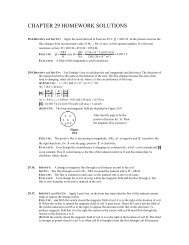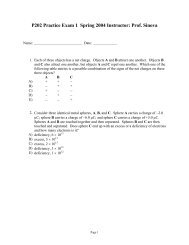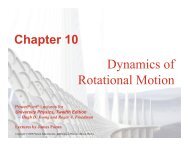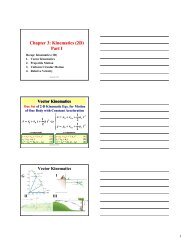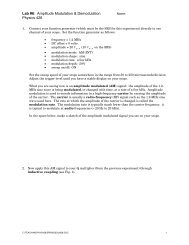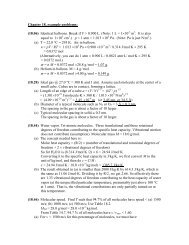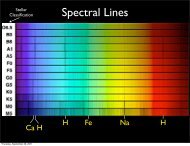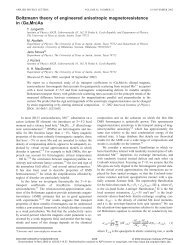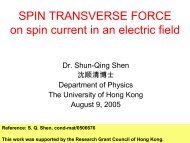Physics 201 MWF9:10 Fall 2008 (Ford)
Physics 201 MWF9:10 Fall 2008 (Ford)
Physics 201 MWF9:10 Fall 2008 (Ford)
You also want an ePaper? Increase the reach of your titles
YUMPU automatically turns print PDFs into web optimized ePapers that Google loves.
Exam 2 Chapts. 6-8 in Young&Geller<br />
Lab Section Number______________<br />
Iarne (signature as on ID)<br />
(c) negative<br />
(b) positive<br />
mn long string. As the rock passes through its lowest point, with the string vertical, the<br />
(5 pts) 3. In question 2. the work (lone by the normal force on the rock is<br />
(b)tie<br />
(a) zero<br />
force on the rock is<br />
of the incline. During the motion from point A to point B. the work done by the gravity<br />
(5 pts) 2. A block slides up an incline from point A at the bottom to point B at the top<br />
(e) <strong>10</strong>.8 rn/s<br />
(c) 7.67 m/s T<br />
(a) 4 43 ni/s<br />
(f) none of the above values<br />
(b) 6.26 rn/s<br />
(d) 8.85 rn/s ‘J 7<br />
tension in the string is T = 3.92 N. At this point the speed of the rock is<br />
(6 pts) 1. A small rock with mass m = 0.20 kg swings back and forth on the end of a 2.0<br />
Multiple Choice questions. Circle the correct answer. No work needs to be shown.<br />
<strong>Physics</strong> <strong>201</strong> <strong>MWF9</strong>:<strong>10</strong> <strong>Fall</strong> <strong>2008</strong> (<strong>Ford</strong>)<br />
Name (printed)__________
(c) negative<br />
L 2I<br />
(a) zero<br />
(a) 5000 J<br />
(f) none of the above answers<br />
(e) <strong>10</strong>0 J<br />
L20J<br />
LJT1<br />
one end of a horizontal spring. The other end of the spring is attached to the wall. A 2 kg<br />
block traveling horizontally at <strong>10</strong> m/s strikes the 98 kg block and sticks to it. After the<br />
collision the maximum elastic potential energy stored in the spring is<br />
(6 pts) 6. A 98 kg block is at rest on a horizontal frictionless surface and is attached to<br />
TiitwF echangein momentum for thes kg block is greater than the mag<br />
nitude of the change in momentum for the 55 kg block<br />
nitude of the change in momentum for the 55 kg block.<br />
the magnitude of the change in momentum for the 5 kg block is the same as the mag’<br />
of the e_emenm for the —_<br />
(a) the magnitude of the change in momentum for the 5 kg block is less than the magnitude<br />
a 55 kg block that is initially at rest. Which of the following statements is correct.:<br />
(5 pts) 5. On a horizontal frictionless surface a 5 kg block moving a.t 8 rn/s collides with<br />
the motion from A to B the total work (lone O1 the object is<br />
(5 pts) 4. At point A an object has speed 8 m/s. At point B it has speed 12 rn/s. During
and is constant. The tension in the string is T = 40 N.<br />
circle at constant speed. The angle between the string and the vertical direction is 37°<br />
(18 pts) 7. A small rock attached to one end of a 50 in long string swings in a horizontal<br />
Ans.<br />
(h) How much time does it take the rock to complete one complete revolution<br />
Ans. ;<br />
(a) What is the mass of the rock<br />
—<br />
—<br />
I<br />
your answers in the blanks provided.<br />
On the following problems show all your work. Partial credit will be given if earned. Write
(18 pts) 8. On Planet X you throw an object straight up with a speed of 8 rn/s and find<br />
that. it reaches a maximum height of 18 iii above the point from which it was thrown. The<br />
mass of Planet X is 6.0 x <strong>10</strong>24 kg. What. is the radius of Planet X<br />
Ans.
(16 pts) 9. A block with mass 2.0 kg is released from rest at point .4 on a metal track and<br />
slides to point B. as shown on the sketch. At point B the block has Speed tB = 5.0 rn/s.<br />
Point A is 8.0 ni above the ground and point B is 2.0 rn above the ground. How much<br />
work is done on the block by friction as the block moves from point A to point B (You<br />
must indicate whether your answer is positive or negative.)<br />
Ans. —<br />
(7 i
[j<br />
Ans.<br />
L_1<br />
(a) What is was the initial speed of block A<br />
east with speed i’ and block B (mass 1.0 kg) is sliding north at speed ‘Bi• The blocks<br />
(16 pts) <strong>10</strong>. On a horizontal frictionless surface block A (mass 2.0 kg) is sliding toward the<br />
(b) What is was the initial speed ‘m of block B<br />
collide and stick together. After the collision the combined object is moving at 37° north<br />
of east at (if = 6.0 rn/s.<br />
Ans. ii I_s



